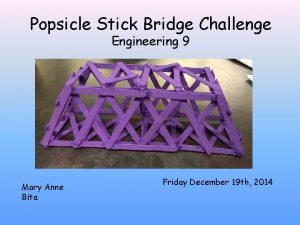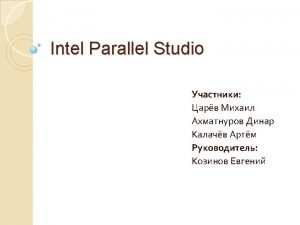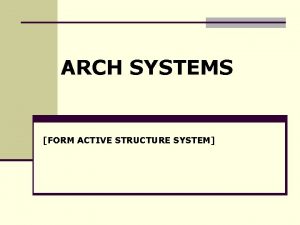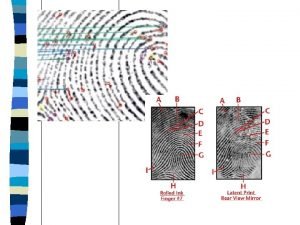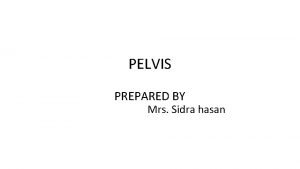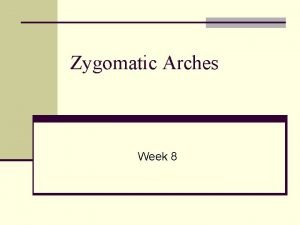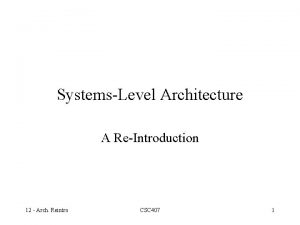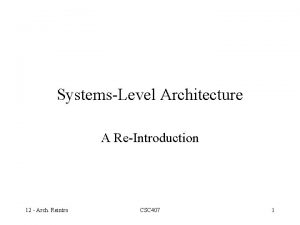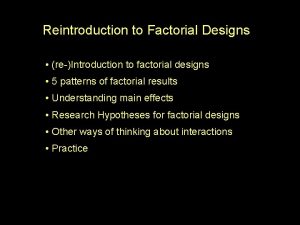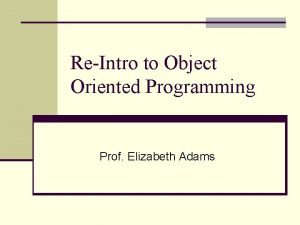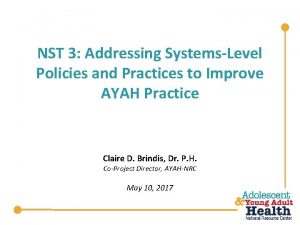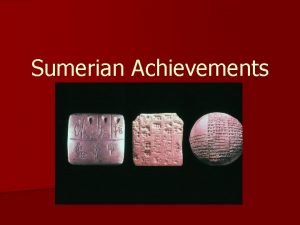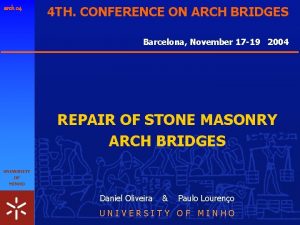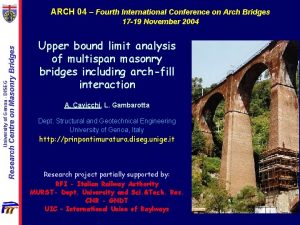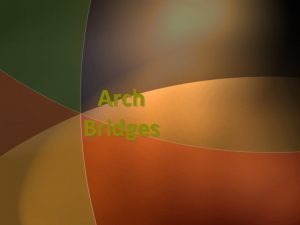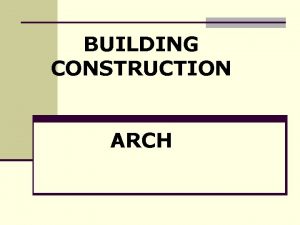SystemsLevel Architecture A ReIntroduction 12 Arch Reintro CSC




















- Slides: 20

Systems-Level Architecture A Re-Introduction 12 - Arch. Reintro CSC 407 1

Level of Design • Divide into two levels: – System-Level Architecture – Programming-Level Design • You know what design is – OOD + written text = one example • Next we will discuss architecture 12 - Arch. Reintro CSC 407 2

Architecture & Design • Architecture – High-level – Major decisions – Not even thinking about programming • Design – “Laying out” the programming language code used to implement the architecture – Organizing programming language concepts 12 - Arch. Reintro CSC 407 3

Design & Architecture in the Development Process Requirements Architecture Design Code & Unit Test C&ut Design C&ut Integration Test System Test 12 - Arch. Reintro CSC 407 4

Architecture Definition • A “software architecture” is the structure (or structures) of a system, which comprise – software components, – the externally visible properties of those components, – and the relationships among them. Logic App Generic GUI Win 32 12 - Arch. Reintro CSC 407 5

Components & Structures • Architecture defines “components” – an abstraction – suppresses details not pertinent to its interactions with other components • An architecture comprises more than one structure • modular structure (calls/uses) • process structure (invokes, communicates with, synchronises with) • physical structure (libraries, DLL’s, processors) • inheritance structures (inherits) • … 12 - Arch. Reintro CSC 407 6

Link to Design in Java-Speak • Referring to the modular structure – The "system" is the whole thing – A "sub-system" is the division into components of • the system • or of a sub-system – At the lowest level, • leaf sub-system = package – A package contains • a set of classes – Traditional to use the (hierarchical) directory structure to represent the system breakdown. • = hierarchical package structure in Java – Coupling and Cohesion (information hiding) guide the architectural division into sub-systems. – Must constrain who calls whom • imports, exports 12 - Arch. Reintro CSC 407 7

Software Architecture • Specifying at the highest level the construction of the system: – Technology choices • Platforms, language, database, middleware, … – System construction • Overall pattern: Monolithic, RDBMS, client/server, 3 -tiered, ntiered, distributed, … • Hardware interfaces (if any) – Division into programs • E. g. a program for data entry, another for data analysis, a Weboriented interface, … – Division of programs into major subsystems • Reuse strategy (shared subsystems) • Calls constraints • Major strategies (e. g. , for persistence, IPC, …) 12 - Arch. Reintro CSC 407 8

The Essence of the Architecture Document • Imagine after the system has been built attempting to describe as cogently and in as compact a form as possible how the system has been put together. • Be utterly clear • you only have an hour in which to do it. • your target audience is knowledgeable professionals in the field, but unfamiliar with the domain. • They will wish to evaluate your choices 12 - Arch. Reintro CSC 407 9

Documentation of an Architecture • Golden Rule of Software Development: – If it’s not reviewable (written down), it doesn’t exist. • Architectures sometime suffer from over-elaborate documentation – Unnecessary. Simply document your decisions. – Most systems don’t deserve elaborate architectural documentation • Dealing with unknowns – Indicate they are unknown for the present – Cycle back later and add new decisions taken – But beware of costs of postponing decisions • Must religiously keep architecture document up-to-date – Very hard to do in practice: takes effort – Therefore keep it simple as possible (but no simpler) 12 - Arch. Reintro CSC 407 10

Two Main Architectural Structures • Modular structure – Purely static – Disappears at run-time • Structures that survive through execution – E. g. , pipes, processes, networks, objects, … • Both views need to be considered (not the same) 12 - Arch. Reintro CSC 407 11

Documentation • Architecture – Informal diagrams – Written explanations – Bullet points • Design – Formal UML – Reflects and in-synch with program structure – Simplify and divide into small chunks for presentation – Add written explanations. 12 - Arch. Reintro CSC 407 12

Sample Systems Architecture Document • Introduction – – purpose of current document what we are building and why references to other documents important business considerations • Technical Requirements – platforms, portability, hardware available, existing systems • Application architecture – user-facing apps • Architectural paradigm – general idea of the system • Data Architecture – how to load/store/write/warehouse data • Run-Time & Physical architecture – processes/threads communications, allocation to hardware • Technology choices – databases, languages, app/web servers, libraries, networks & IPC • Module architecture – source code, re-use strategy 12 - Arch. Reintro CSC 407 13

Why is architecture important? • Manifests early design decision – most difficult to get correct and hardest to change – defines constraints on the implementation – inhibits or enables quality attributes • Defines a work-breakdown structure – organization (especially important for long-distance development) – estimation – architecture document provides the vocabulary • A vehicle for stakeholder communication – an architecture is the earliest artefact that enables the priorities among competing concerns to be analysed • Reviewable – architectural errors are vastly more expensive to fix once a system has been coded – Can serve as a basis for training new developers – As an indication of progress 12 - Arch. Reintro CSC 407 14

Must Answer • Two questions – What structure shall I employ to • • Assign workers Derive a work breakdown Exploit pre-packaged components Plan for modification – What structure shall I employ so that • the system, at runtime, fulfills its behavioral and quality attributes. 12 - Arch. Reintro CSC 407 15

Functionality & Quality Attributes • Functionality usually takes 1 st place during development. • Systems are more frequently re-designed not because they are functionally deficient, but rather because – – – They are difficult to maintain Difficult to port Won’t scale Too slow Too insecure Not fault tolerant 12 - Arch. Reintro CSC 407 16

System Qualities • Observable via execution – Performance – Security – Availability • Reliability = mttf = mean time to failure • Availability = mttf/(mttf + time to repair) – Functionality – Usability • Not observable via execution – – – Modifiability Portability Reusability Integrability Testability 12 - Arch. Reintro CSC 407 17

Business Qualities – Time-to-market – Cost – Projected lifetime – Target market – Rollout schedule – Use of legacy systems 12 - Arch. Reintro CSC 407 18

Architectural Qualities • • Conceptual integrity Correctness Completeness Buildability – Completed by available team in a timely manner 12 - Arch. Reintro CSC 407 19

Architectural Paradigms in Common Use • Monolithic Systems – single/multi threaded • Client/Server – roll your own • Classic RDBMS C/S – ex. Java JDBC • Distributed Systems – ex. Java RMI • N-tiered systems – ex. Java EJB 12 - Arch. Reintro CSC 407 20
 What is architecture business cycle
What is architecture business cycle Bus architecture in computer architecture
Bus architecture in computer architecture Call and return architecture in software engineering
Call and return architecture in software engineering Modular product architectures
Modular product architectures Integral and modular architecture
Integral and modular architecture Hopewood house study
Hopewood house study Dual arch impression technique
Dual arch impression technique Popsicle stick bridge challenge
Popsicle stick bridge challenge Non anatomic teeth indications
Non anatomic teeth indications Recurrent laryngeal nerve
Recurrent laryngeal nerve Series arch
Series arch Afis fingerprint
Afis fingerprint Cpu arch
Cpu arch Gothic arch greenhouse advantages
Gothic arch greenhouse advantages Major branches of abdominal aorta
Major branches of abdominal aorta Non form active structure
Non form active structure Island ridge minutiae
Island ridge minutiae Extraoral gothic arch tracing
Extraoral gothic arch tracing Sidra hasan
Sidra hasan Zygomatic arch view positioning
Zygomatic arch view positioning Patent impressions are
Patent impressions are







